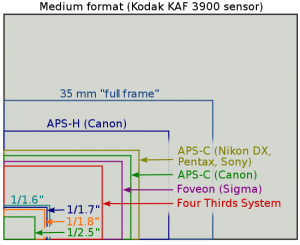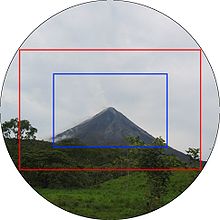1. What is the sensor size ?
Surprisingly, this happens to be the most important question. The camera sensor has been standardized with the olden days films which used to be of 35mm x 24mm. In plain language, the bigger size of the sensor enables more of the image to be formed and thus enhances the quality of the image. However very few cameras are of the 35 mm format as of now and most of them come with what is called a ‘cropped sensor’. For example the high end DSLRs have sensors with 28.7mm x 19.1mm, the entry levels are 24mm x 16mm and most of the digital cameras are 8.8mm x 6.6mm.
Lets see what difference does a sensor make. Well, they affect the ‘crop factor’ of the lens. The crop factor is the sensor’s diagonal size compared to the 35 mm format. In case of DSLRs like D3000, the crop factor comes to 1.5x, i.e.; a photograph will be cropped 1.5x when compared to a 35mm lens. So an 18mm on D3000 is actually 18×1.5= 24mm, thats the most wide angle you can get. This brings the feeling of zoom as well as results in the discarding of details on the side. The smaller the sensor size, the higher is the cropping and the ability of the camera to take the ‘whole picture’. This is why the point and shoots are able to provide very high zooms like 20x and so, at the cost of the image area. I am not saying that smaller sensors are bad, but you must know what is their size. Be ready to squirm if its too small, size matters in photography too!
2. What is the sensor type?
After the sensor size, its again the sensor. You need to know what is the sensor type. In today’s times, broadly two types of sensors are available in the market: CCD and CMOS. CCD- Charged Coupled Device are used in most point and shoots and a few DSLRs. Although they capture good quality images, the power consumption of cameras with CCD sensors is high and the overall price is also on the higher side.
On the other hand, the CMOS- Complementary Metal Oxide Semiconductor sensors are bigger than the CCD ones and hence able to capture more light. The image quality is better on account of them being more sensitive, power consumption is lower and the costs tend to be lower. So based on the pros and cons of both, you must be able to decide which one do you want for your camera.
3. How many Megapixels? What is the pixel size ?
Megapixels is the biggest farce that has ever been created in the Camera industry IMHO. Do you want to take photograph of poster size? If not then why do you need cameras with obscenely high megapixels? Instead of asking about how many megapixels the camera has you should instead ask what is the pixel size provided.
Each pixel is a semiconductor material that absorbs the photon and generates electron. Going by common sense, at any given time, the number of photons captured by the pixel should increase as the pixel size increases. Hence the signal to noise ratio in a camera is directly related to the size of the pixel. In layman’s term, the bigger the better. The following illustration taken from Clarkvision will show it in better way.
4. What is the battery being used?
If I had to advise, never ever go for the cameras that come with the AA alkaline batteries. They suck big time! Always go for cameras which come with either Lion or at least the Ni-Cad batteries. These cameras will cost a bit more for the same configuration, but believe me they are value for money.
5. What kind of zoom is there?
Digital zoom was the second biggest farce by the Camera making companies which fortunately did not take them a long way. Digital zoom is nothing but magnification of the image electronically, resulting in loss of details and thus useless. So discount any digital zoom and concentrate only on the Optical zoom. You must be able to relate the zoom with the sensor size and see if it all looks ok, as even a high zoom rating with a tiny sensor is not a good news. For DSLRs you need not bother with this.
6. What about the VR?
For the cameras which come with VR- Vibration Reduction, you should be interested to know the ratings. The relationship between Vibration and Focal length is as follows: For any given focal length, a hand held camera must be at a shutter speed which is inverse of the focal length. For example, with a focal length of 50mm, the minium shutter speed to avoid camera shake has to be 1/50 sec.
So what does a VR do? Notwithstanding what the lens makers say, a good VR mechanism decreases the effective shutter speed for any given focal length by two stops. So for a 50mm focal length it now comes down to 1/12.5 sec. This is what you should be looking for. If the VR ratings are inferior to the 2 stop concept, be ready to discount it and negotiate.
So this is all I have to say now for buying a digital camera. Will keep updating this page for your use. Till then, happy shopping ! 🙂
PS: All the photographs in this article have been taken from internet. This is from the days when I was not that aware about giving photo credits. Hence I take this opportunity to thank and praise the original contributors of these photographs. You guys rock!


